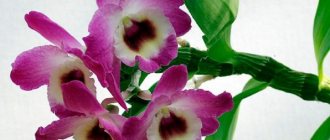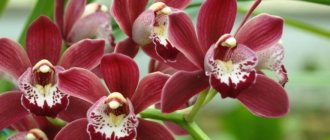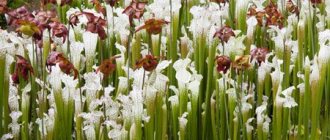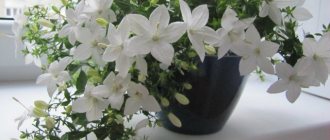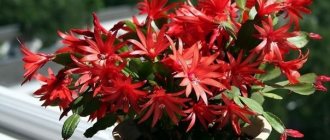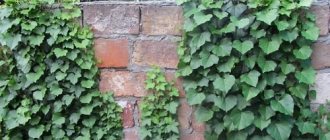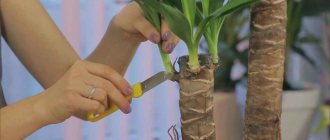Zamia is a houseplant from the Zamiaceae family. Belongs to the cycad genus. Medium sized flower, evergreen. Translated from Latin as “damage” and “loss”. It was developed more than two hundred years ago.
Zamia is a flower native to the American continent. Many have a pear-shaped trunk and are located under the ground. The foliage is located one after another along the entire length, almost from the roots to the very top.
You can see a photo of the zamia plant below.
The leaf is oblong-oval and not wide, located on a long petiole. At first it looks like a fern (shaped like a curled snail). Divides into two parts at the base.
Types of zamia
There are 58 species of zamia plant.
Florida Zamia
It has an elongated long root. The strobile is located above the ground. The trunk is medium long, the leaves have a leathery tint and a smooth surface.
Zamia latifolia
The leaves reach a meter in length. Part of the low (up to 10 cm) trunk is above the soil.
Dwarf zamia
It is the smallest representative of the species. The trunk under the ground reaches 25 cm. The leaves are from 5 cm to 50.
Pseudoparasitic zamia
At home, the trunk reaches 3 m in height. It grows very slowly. It has sparse leaves up to 2 m in length.
Zamia scaly
The trunk of the plant reaches a meter in height. When indoors, the stem, which should be underground, protrudes to the surface. The leaves are fleecy. The leaves grow up to a meter in length.
Siliceous zamia
The trunk is completely hidden in the ground. A few leaves (3-5 pieces) are spread over the surface. Receives nutrition from an underground tuberous trunk.
Description of the flower
The structure of Zamioculcas is very unusual.
The Dollar Tree does not have a trunk, stems or branches like other trees. What grows from the soil is a compound leaf formed directly from the rhizome. The root system of Zamioculcas is a large underground tuber from which thick, worm-like roots extend. The leaves of Zamioculcas are erect, glossy, with a waxy coating. They grow on fleshy petioles thickened at the bottom. The leaves grow from 40 to 60 cm in length. They are complexly pinnate, divided into 8 - 12 separate leaves - feathers. The leaf axis (rachis) is juicy and thick. The petioles and rachis are covered with ink-colored spots. The leaves are feathers that are very dense and leathery.
The Dollar Tree grows very slowly. Only a few new leaves appear per year. The growth is about 10 - 15 cm. But with good care, during its life it can reach a meter in height and even higher. In dry times, this evergreen flower can get rid of its leaves - feathers - to avoid excessive evaporation of moisture.
The petioles and central vein of the leaf (rachis), at the same time, will remain on the plant. Like tubers, leaves and petioles have the ability to accumulate moisture and nutrients whenever possible - this is how the plant has adapted to long periods of drought in its homeland. The lifespan of this succulent is from five to ten years. If you have one copy, take care of its reproduction in advance.
Bloom
This is how Zamioculcas blooms
Zamioculcas blooms extremely rarely even in its natural conditions, and only in adulthood. In appearance, the Dollar Tree inflorescence looks like a thick cob, which contains small, inconspicuous flowers of a light cream or yellowish hue. The spadix is formed in the lower part of the flower on a short thick peduncle.
You won't notice it right away, since it is usually covered with a pale green petal - a blanket. In indoor conditions it blooms only under ideal conditions after three years after planting. The flowering time is most often at the end of spring, but sometimes the cob appears at the end of autumn, before the onset of cold weather. Flowering is long lasting.
The aroma is fragrant, pleasant. But the seeds do not set even with artificial pollination. Experienced gardeners usually remove the inflorescence early, as it is not of particular interest. In nature, after the flowering of Zamioculcas, berries with one seed in each of them may appear and ripen. It has been noticed that the Dollar Tree usually blooms at the end of its life.
With the light hand of office plankton, the plant began to be called the “dollar tree”, since the flora of the offices of that time, although it was not too diverse, however, “money” and “dollar” trees, according to legend, attracting money to the company, were constant attributes of any commercial design style . Particularly ironic is the fact that the birthplace of the “dollar tree” is one of the poorest countries on our planet – Mozambique. Be that as it may, the plant gained popularity because it combined a beautiful appearance and unpretentious living conditions.
Zamioculcas is a thick-stemmed evergreen herbaceous crop with a massive rhizome. Its leaves are dark green in color with a characteristic glossy tint. The leaves themselves have small swellings at the base.
The length of the leaves can reach up to 1 meter. The plant can accumulate moisture in case of drought and shed leaves if the stored moisture runs out and there is no watering. The plant is perennial, with a slow rate of growth and the appearance of new stems and leaves.
At home
Zamioculcas is a monotypic plant, that is, the only species of its kind. And taking into account the fact that the plant has been cultivated by humans under artificial conditions for no more than half a century, the number of varieties and varieties of Zamioculcas is small. Its first varieties appeared no more than 10 years ago and were not widely used.
The Zamioculcas flower looks like a small ear of corn; its length is approximately 5-6 cm. It grows on a separate stem and is pollinated naturally. As a rule, during the flowering period, the plant has several flowers.
dollar tree flower
Growing conditions
Let's look at caring for zamia at home.
The plant is quite easy to grow. No strict temperature, humidity or light conditions are required. It is important to know that the plant is poisonous. People and animals are susceptible to poisoning by its poison.
Light
The flower loves good light. But you should not expose it to direct rays of the sun. If possible, it is better to display on window sills facing south, east or west. Place centrally to achieve uniform light output.
Too much illumination is undesirable. The zamia plant may get burned. In good warm weather, it is allowed to take it outside. But at night, be sure to return it back to the room. It is important to carry out regular ventilation.
Interestingly, the flower can learn to withstand hot and direct sunlight. But for this you need to first and gradually prepare it.
Temperature
Since the plant comes from the tropics, it loves humidity and warmth. In summer, the temperature is maintained between 20 and 25 degrees. In autumn and winter, it is impossible for it to fall below 10 degrees. Otherwise, the flower will become hypothermic and die.
You may be interested in the article: Unpretentious indoor plant aspidistra - a flower for the lazy.
But zamia can tolerate short-term exposure to temperatures down to 0 degrees. Unless, of course, the change in thermal regime occurred very abruptly.
Humidity
As already mentioned, high air humidity is the most preferable option for a comfortable existence. It is enough to carry out daily spraying of the foliage and the space around the plant. Every few weeks, wipe the foliage from dust with a soft cloth.
Very dry and too hot air is difficult to tolerate. Therefore, you should not place the flower near heating appliances. But it will feel great near an aquarium or humidifier.
Watering
Zamia should be watered in moderation. But at the same time, the surface layer of soil should not be allowed to dry out. Overwatering is also dangerous and leads to the formation of various types of rot. Water at room temperature (or slightly warmer) is suitable for irrigation. You can put water for irrigation in the sun and use it. The main thing is not to use hot and ice.
On average, the regularity of watering a flower is once a week. During autumn-winter temperature drops, the frequency is reduced to 3 times every 4 weeks. The main symptom of drying out is yellowing and falling leaves.
Soil for zamia
The flower is suitable for almost any type of soil. But a clay-based substrate would be more appropriate. Can be diluted with coal, fine squeak, leaf soil, expanded clay.
Top dressing
Both liquid and dry mixtures are suitable for fertilizing zamia. In spring and summer, feed every 20 days. In late autumn and winter, all complementary foods are removed.
2.Care for zamia at home
2.1.Reproduction
Seeds are sown in spring and summer in damp sand. Place the pot with seedlings in a warm place with a temperature of at least 18 ° C and cover with a plastic cap or glass to maintain humidity. Germination is very long, young plants develop slowly. Fresh seeds have the best germination rate. Young plants should not be kept in direct sunlight until the second pair of true leaves appears.
2.2.How to care
Quite hardy indoor plants that do not require much care. Grow zamia in well-drained soil and indoors with good light. Remove dead leaves promptly. Turn the plant periodically with different sides towards the light source - in this case it will look symmetrical and attractive.
2.3.When does zamia bloom?
It blooms extremely rarely in cultivation.
2.4.Transplant
In spring, when the root system becomes cramped. Large adult specimens do not need to be replanted, but simply replace the top layer of soil 5–7 cm thick every year with a fresh one.
2.5. Watering zamia
Water the zamia abundantly throughout the summer, allowing the top layer of soil, about 5 cm thick, to dry out. In the cold season, reduce the frequency of watering. When watering, avoid getting water on the trunk and leaves - they may rot.
2.6.Zamia diseases and pests
If there is a lack of moisture, the plant may shed its leaves. When overwatered, root rot appears.
Zamia is predisposed to the appearance of pests such as spider mites and scale insects.
Zamia transplant
Until the flower reaches five years of age, transplantation is carried out annually. Over time, they begin to perform it at intervals of 2-3 years. Zamia grows very slowly, and replanting also slows down growth.
Be sure to line the bottom of the new pot with a drainage layer. Then the plant is placed there using the transshipment method. That is, the root ball does not need to be cleared of soil. Above add layers of humus, peat, leaves, clay and coal.
The appearance of foliage does not occur simultaneously. It develops gradually. One leaf after another. That is why zamia grows slowly, each leaf is not easy. The flower is not pruned. This could be disastrous for him.
Reproduction of zamia
Reproduction of the plant is possible only with the help of seeds. The best soil for planting them is peat and coarse sand. The seeds are not buried completely. Then they are left in a warm and bright place until shoots emerge. The temperature for germination should be from 15 to 20 degrees. The air is humid.
The appearance of the first shoots takes a very long time. At this point, some seeds even lose their germination properties. Therefore, usually not all cuttings appear. Avoid exposure to direct sunlight.
Indoor zamia flower, care, description with photo
Zamia is a typical representative of the genus Cikada (Sagovnikov) from the Zamiev family, which unites a group of some of the most ancient plants on the planet - “living fossils” that have survived on earth since the time of dinosaurs.
Most species grow in the warm, moist understory of tropical forests in North and South America. Some of them adapt well to subtropical climates and are used in garden landscaping.
However, as a houseplant, powdered zamia (Zamia furfuracea) is of particular interest to gardeners, caring for it at home is not difficult.
Pests and diseases
Zamia is quite unpretentious. It can withstand many care imperfections. But it is still possible that a number of problems may arise that can lead to the death of the plant.
- The combination of nitrogen fertilizer and too high a moisture level leads to rotting of the roots.
- Prolonged exposure to direct sunlight leads to burns. They manifest themselves as discoloration or yellowing of foliage.
- The plant may die from increased moisture along with hypothermia.
- Shoot growth is very slow. They may not change in any way even for several years.
- There may be insect pests that feed on the sap of the plant. These are scale insects (suck to leaves), aphids (small whitish insects), spider mites (small red bugs).
The scale must be manually removed from the leaf, which should then be treated with a soap solution. The most effective way to control insects is chemical treatment. As a rule, it is performed in several stages.
We recommend that you read the article: How to grow boviea correctly: with photographs.
After the first procedure, treat the back side of the leaves with a soap solution. After seven days, re-treatment is carried out. The action of such products is based on the poisoning of plant juice, which the pests die by drinking.
It is important to note once again that the flower is completely poisonous. It should never be allowed to get into food. Animals are also prohibited from licking the juice or chewing the plant. A careful approach will prevent possible cases of poisoning.
Diseases and pests
The most common problem when caring for zamioculcas is yellowing of the leaves.
There are two reasons: if old leaves turn yellow, then this is a natural process of replacement with young leaves, and if new leaves begin to turn yellow, then the reason may be constant waterlogging of the soil, which has led to rotting of the roots.
In some cases, if the process is not too advanced, the plant can still be saved; to do this, it must be pulled out of the pot, carefully shake off the soil, inspect the root system and cut off the rotten parts. Treat the cut areas with charcoal and spray the entire plant, for example, with Fundazol, let it dry a little and plant in new soil and pot.
- During prolonged periods of drought, the leaves begin to fall off, but as the rhizome continues to develop, new leaves will appear when watering is resumed.
- Parasites rarely appear on zamioculcas, this is most likely due to the fact that they do not like the thick peel that protects the leaves. If the leaves become discolored and curl, these are signs of aphid infestation. You can destroy aphids with any plant parasite remedy, if possible, after first cleaning the leaves and stem with a damp sponge to remove aphids.
- If dark spots appear on the leaves, it means the room temperature is too low (below 15°C), drafts or frequent watering.
- Dark stripes and spots on the stem are a normal feature of the plant, only if at the same time there are no soft, wet areas - these are signs of rot.
- Dark spots on the leaves and stem may also be evidence of scale infestation.
Zamioculcas is better known as the “dollar” or “money tree”. Many people believe in the sign of prosperity and financial wealth of the house where this tenant has settled. The plant is unpretentious and does not require special conditions. It takes root well on any windowsill at home and does not require complex care. It pleases its owners with green leaves all year round. Zamioculcas is a perennial.
Most of the best houseplants grow slowly, and Zamioculcas, being one of the best, is no exception. Zamioculcas spreads easily at home and is replanted, but it does not develop quickly, increasing in growth step by step, so be patient.
Like all indoor plants, Zamioculcas is excellent at improving indoor air quality. But unlike others, it can also improve the health of people in living spaces, as it was recently discovered that Zamioculcas can remove carcinogens such as benzene, which are often found in home environments.
The homeland of Zamioculcas is tropical Africa. There is only one species in the aroid family, the full name of which is Zamioculcas zamiifolia. Zamioculcas can be found in nature in Tanzania, especially in the Zanzibar region; the plant inhabits central Africa and the eastern coast of the continent. The plant's natural environment consists of rocky soil in lowlands or highland foothills. Zamioculcas is accustomed to long periods of very dry weather alternating with heavy rains.
Zamioculcas has been known as a botanical species since 1892, but has only become popular as a houseplant within the last 15 years or so. This happened thanks to Dutch producers who took on the task of growing it in 1996 for home breeding.
Green, beautiful and practically indestructible: Zamioculcas is, above all, a fabulous work of nature. The green personality has strong, prominent, leathery leaves that grow on branches that look a bit like feathers. Despite its robust stems, Zamioculcas is still classified as an herbaceous plant.

